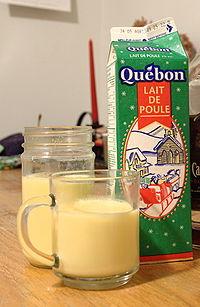Eggnog

Eggnog is a sweetened dairy-based beverage made with milk, cream, sugar, beaten eggs (which gives it a frothy texture), and flavoured with ground cinnamon and nutmeg; alcoholic versions also exist with the addition of various liquors, such as brandy, rum, whiskey, advocaat and/or Baileys Irish Cream.
Eggnog is a popular drink throughout the United States and Canada, and is usually associated with winter celebrations such as Christmas and New Year. Commercially, non-alcoholic eggnog is available around Christmas time and during the winter.
History
The origins, etymology, and even the ingredients used to make the original eggnog drink are debated. Eggnog, or a very similar drink, may have originated in East Anglia, England, though it may also have been developed from posset (a medieval European beverage made with hot milk). An article[1] by Nanna Rögnvaldsdóttir, an Icelandic food expert, states that the drink adopted the "nog" part of its name from the word "noggin", a Middle English term used to describe a small, wooden, carved mug used to serve alcohol. Another name for this British drink was Egg Flip. Yet another story is that the term derived from the name "egg-and-grog", a common Colonial term used to describe rum. Eventually the term was shortened to "egg'n'grog", then "eggnog".[2]
The ingredients for the drink were too expensive and uncommon for the lower classes, but it was popular among the aristocracy. "You have to remember, the average Londoner rarely saw a glass of milk," says author and historian James Humes (To Humes It May Concern, July 1997). "There was no refrigeration, and the farms belonged to the big estates. Those who could get milk and eggs to make eggnog mixed it with brandy or Madeira or even sherry."[3]
The drink crossed the Atlantic to the English colonies during the 18th century. Since brandy and wine were heavily taxed, rum from the Triangular Trade with the Caribbean was a cost-effective substitute. The inexpensive liquor coupled with plentiful farm and dairy products helped the drink become very popular in America.[4] When the supply of rum to the newly-founded United States was reduced as a consequence of the American Revolutionary War, Americans turned to domestic whiskey—and eventually bourbon in particular—as a substitute.
Ingredients
Traditional eggnog typically consists of milk, sugar, nutmeg, and eggs. Frequently cream is substituted for some portion of the milk to make a much richer drink. Some eggnogs add gelatin. Toppings may include vanilla ice cream, meringue, or whipped cream.
Eggnog can be produced from homemade recipes, however ready-made eggnog containing alcohol and "just-add-alcohol" versions are available for purchase. Whiskey, rum, brandy, bourbon or cognac are often added. Since the 1960s, eggnog has often been served cold and without alcohol, both of which are significant departures from its historical origins. Lowfat eggnog is commercially available or it may be prepared in the home using skimmed or lowfat milk.[5] In North America, a few soymilk manufacturers, including the widely available brand Silk, offer seasonally-available, soy-based alternatives for vegans and those with dairy or milk allergies. The rice milk company Rice Dream also makes a rice nog. Eggnog may be added as a flavouring to food or drinks such as coffee and tea. Eggnog-flavoured ice cream, for example, is a seasonal product in the United States and Canada.
Modern commercial eggnog can be made and sold as eggnog with the following ingredients: Milk, sugar, modified milk ingredients]], glucose-fructose, water, carrageenan, guar gum, natural and artificial flavorings, spices, monoglycerides, colorings.[6][7][8] It has been noted that in spite of the change to more artificial ingredients, commercial eggnog sales remain strong, indicating that the artificial versions have successfully simulated the taste for most consumers.[9] The ingredients in commercial eggnog vary significantly, but generally raw eggs are not included as in traditional egg nog.[10][11]
The FDA has changed or altered the definition of eggnog a number of times as the ingredients have presumably evolved away from the traditional towards more modern artificial replacements for the large number of eggs usually required, and safety concerns in selling products made from raw eggs and milk. According to modern FDA regulations, eggnog can be defined as containing less than 1% egg yolk solids and "milk or milk products"[12][13][14][15]
Significance
Eggnog is typically served as a Christmas drink or during New Year's Eve in the United States and Canada. In the United States, Thanksgiving (late November) falls at the beginning of the season in which eggnog is typically consumed, but the product begins appearing in stores around Halloween and can be found in a small handful of stores year-round. Historically it has been a winter beverage not specifically associated with any holiday.
See also
- Ponche crema
- Kogel mogel
- Soda sữa hột gà
- Advocaat
- Zabaglione
- Coquito
- Eierpunsch
- Rompope
- Cola de mono
- Tamagozake
External links
References
- ^ Rögnvaldardóttir, Nanna. "History of Eggnog". What's Cooking America. Retrieved 2006-12-16.
{{cite web}}: Unknown parameter|coauthors=ignored (|author=suggested) (help) - ^ http://www.thenibble.com/reviews/main/cocktails/mount-gay-egg-nog.asp
- ^ Robinson, Oliver (2006-12-15). "Bottoms Up: Eggnog". that's Beijing Magazine and Blogs. True Run Media. Retrieved 2006-12-16.
- ^ Block, Stephen. "The History of Egg Nog". Food History. The Kitchen Project. Retrieved 2006-12-16.
- ^ Low Fat Eggnog
- ^ http://www.scotsburn.com/Product/EggNog/OrgnNog.htm
- ^ http://www.dairyingredientsinc.com/2_1_2.html
- ^ http://ohioauthority.com/articles/food-and-drink/cocktails-101-ruminations-on-eggnog
- ^ http://www.nytimes.com/1996/12/25/garden/the-remaking-of-eggnog-popular-heavyweight-champ.html
- ^ http://www.zeer.com/Food-Products/Hood-Light-Egg-Nog/000042723
- ^ http://www.robertsdairy.com/products/seasonal/lite-egg-nog
- ^ http://www.fda.gov/Food/FoodSafety/Product-SpecificInformation/MilkSafety/CodedMemoranda/MemorandaofInterpretation/default.htm
- ^ http://www.fda.gov/ICECI/ComplianceManuals/CompliancePolicyGuidanceManual/ucm074481.htm
- ^ http://www.fda.gov/Food/FoodSafety/Product-SpecificInformation/MilkSafety/CodedMemoranda/MemorandaofInformation/ucm079112.htm
- ^ http://www.grokfood.com/regulations/131.170.htm
- Rombauer, Irma S. and Marion Rombauer Becker (1931 [1964]) The Joy of Cooking, pp 48, 50. Indianapolis: Bobbs-Merrill. ISBN 0-452-25665-8.
